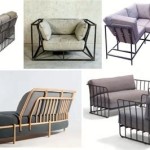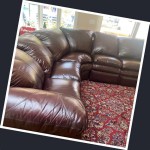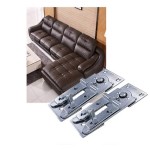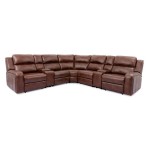The Best Sectional Sofas: A Comprehensive Guide
Sectional sofas have become a staple in modern living rooms, offering comfort, versatility, and ample seating. Their modular design allows for customization and adaptation to various spaces, making them a popular choice for both small apartments and large family homes. Selecting the "best" sectional sofa, however, requires careful consideration of several factors, including size, material, style, and budget. This article aims to provide a comprehensive guide to understanding and choosing the sectional sofa that best suits individual needs and preferences.
The sheer variety of sectional sofas available on the market can be overwhelming. From classic L-shaped designs to expansive U-shaped configurations, the options seem endless. Before embarking on the search, it is essential to define the intended purpose of the sectional, the available space, and the desired aesthetic. A clear understanding of these parameters will significantly narrow down the choices and streamline the selection process.
Materials play a crucial role in the longevity, comfort, and overall appearance of a sectional sofa. The frame, upholstery, and filling all contribute to the final product. Understanding the characteristics of different materials is crucial for making an informed decision that aligns with lifestyle and budget.
Understanding Different Sectional Sofa Configurations
One of the most defining features of a sectional sofa is its configuration. The arrangement of individual pieces determines its overall shape, seating capacity, and how it fits within a room. Common configurations include L-shaped, U-shaped, modular, and chaise sectional sofas. Each configuration offers unique advantages and caters to different spatial requirements.
The
L-shaped sectional
is a classic and versatile choice. It typically comprises two main sections that form a 90-degree angle. This configuration is ideal for maximizing corner space and creating a defined seating area in smaller to medium-sized rooms. L-shaped sectionals can be oriented with the longer section on either the right or left, providing flexibility in room layout.U-shaped sectionals
are larger and offer ample seating, making them suitable for larger rooms and families. The U-shape typically consists of three sections, creating a more enclosed and intimate seating arrangement. These sectionals are often used in media rooms or living rooms where socializing is a priority.Modular sectionals
offer the greatest flexibility. They comprise individual pieces that can be rearranged and reconfigured to create various shapes and sizes. This versatility allows for customization and adaptation to changing needs and room layouts. Modular sectionals are ideal for individuals who value flexibility and the ability to personalize their seating arrangement.Chaise sectionals
feature an extended section that forms a chaise lounge. This configuration is perfect for relaxing and stretching out, adding a touch of comfort and luxury to the living room. Chaise sectionals can be oriented with the chaise on either the right or left, depending on the room's layout and personal preference.The choice of configuration should be based on the size of the room, the desired seating capacity, and the intended use of the sectional. Careful consideration of these factors will ensure that the chosen configuration complements the space and meets the needs of the user.
Exploring Material Options for Sectional Sofas
The materials used in a sectional sofa significantly impact its comfort, durability, and aesthetic appeal. Selecting the right materials requires understanding the properties of different options and considering factors such as lifestyle, budget, and personal preferences. The frame, upholstery, and filling all play critical roles in the overall quality and performance of the sectional.
The
frame
provides the structural support for the sectional. Hardwoods, such as oak and maple, are known for their strength and durability. Softwoods, such as pine, are more affordable but may not be as robust. Engineered wood, such as plywood and particleboard, is a common alternative that offers a balance of cost and durability. A well-constructed frame is essential for ensuring the longevity of the sectional.Upholstery
is the visible surface of the sectional and plays a crucial role in its comfort and style. Common upholstery materials include fabric, leather, and synthetic options. Each material offers unique advantages and disadvantages.Fabric upholstery
is available in a wide range of colors, patterns, and textures. Natural fabrics, such as cotton and linen, are breathable and comfortable but may be more prone to staining and wear. Synthetic fabrics, such as polyester and microfiber, are more durable and stain-resistant, making them suitable for high-traffic areas and families with children and pets. The choice of fabric depends on the desired aesthetic, durability requirements, and budget.Leather upholstery
exudes luxury and sophistication. Genuine leather is durable and develops a unique patina over time. However, it is also more expensive and requires regular maintenance. Faux leather, also known as vegan leather or pleather, is a more affordable alternative that mimics the look and feel of genuine leather. It is also easier to clean and maintain, making it a practical choice for busy households.The
filling
of the cushions and backrests determines the comfort and support of the sectional. Common filling materials include foam, feathers, and fiberfill. Foam is a popular choice due to its affordability and ability to retain its shape. High-density foam provides firmer support, while low-density foam offers a softer feel. Feather filling is luxurious and comfortable but requires regular fluffing to maintain its shape. Fiberfill is a synthetic alternative that mimics the softness of feathers but is more durable and hypoallergenic.Selecting the right materials for a sectional sofa requires careful consideration of lifestyle, budget, and personal preferences. A durable frame, appropriate upholstery, and comfortable filling will ensure that the sectional provides years of enjoyment.
Assessing Style and Design Considerations for Sectional Sofas
Beyond functionality and materials, the style and design of a sectional sofa play a significant role in its overall appeal and how it integrates into a living space. The style should complement the existing decor and reflect the homeowner's personal taste. Design considerations include the shape, color, and details of the sectional, all of which contribute to its aesthetic impact.
Sectional sofas are available in a wide range of styles, from classic and traditional to modern and contemporary.
Traditional styles
often feature rolled arms, button tufting, and ornate details. These sectionals are typically upholstered in rich fabrics such as velvet or brocade.Modern styles
, on the other hand, tend to have clean lines, minimalist designs, and neutral colors. They are often upholstered in leather or sleek synthetic fabrics.Contemporary styles
blend elements of both traditional and modern designs, offering a more versatile and eclectic look. These sectionals may feature clean lines with subtle details, such as track arms or tufted backrests. The choice of style should align with the overall aesthetic of the room and the homeowner's personal preferences.Color is another important design consideration.
Neutral colors
, such as gray, beige, and white, are versatile and can easily be incorporated into various decor styles. They also provide a blank canvas for adding pops of color with accent pillows and throws.Bold colors
, such as blue, green, or red, can make a statement and add personality to the room. However, they should be used strategically to avoid overwhelming the space.The shape and details of the sectional also contribute to its overall design. Sectionals with
rounded edges
and plush cushions create a softer and more inviting feel. Sectionals withstraight lines
and structured cushions offer a more formal and sophisticated look. Details such as piping, stitching, and button tufting can add visual interest and enhance the overall design.When selecting a sectional sofa, it is important to consider the existing decor and the desired aesthetic of the room. The style, color, and details of the sectional should complement the other furniture and accessories in the space. A well-chosen sectional can enhance the overall design and create a cohesive and inviting living environment.
The ideal sectional sofa balances comfort, durability, style, and affordability. Before making a purchase, thorough research and careful consideration of individual needs are crucial. By understanding the various configurations, materials, and design options available, individuals can confidently choose a sectional sofa that enhances their living space and provides years of enjoyment.

10 Best Sectional Sofas Of 2024 What Brands Them Home Cozy

The 11 Best Small Sectional Sofas In 2024 Expert Picked

The Best Sectional Sofas Of 2024 For Any Budget

12 Best Sectional Sofas 2024 Designer Voted For Quality Comfort

The Best Sectional Sofas Of 2024 And How To Pick Them Comfort Works Blog Sofa Resources

The 17 Best Sectional Sofas For 2024 Tested Reviewed

13 Best Sectional Sofas 2024

The Large Sectional Couch You Need At Home 20 Best Sofas

11 Best Sectional Sofas Couches 2024 Where To Buy

13 Best Sectional Sofas 2024
Related Posts








